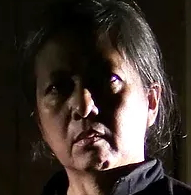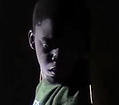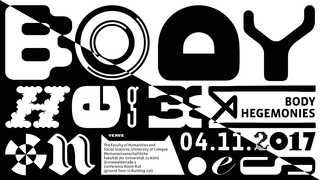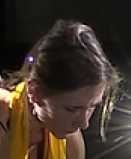The central theme that emerged from the rehearsal process and the final performance of Body Hegemonies was the notion of borders, or what Boaventura de Sousa Santos calls the abyssal line, demarcating who belongs and who is excluded from the dominant discourse — a discourse so powerful as to determine which lives are worth protecting and which can be sacrificed. Bodies in mental institutions; bodies that contain traumatised narratives that find expression in involuntary spasms; bodies bound by precarity and marked as subversive, immoral, or economically useless by political and religious powers; bodies immobile bound to place by violently conflicted and contested histories and unresolved trauma; transnational, shapeshifting, creative, bodies bound by one-dimensional colonial and local discourses; transforming, fluid bodies bound by rigid hegemonic notions of race, gender, class and civic belonging. These bodies are all bound, boxed, and marginalised through the limiting binary logic of Eurocentric modernity, built on a history of imperial expansion, capitalism, and patriarchy (de Sousa Santos, 2014).
Our common point of departure for the five-day workshop was the underlying assumption that 1) in order to understand bodily phenomena, the body needs to play a central role in the research process; 2) the active involvement of the body in the research process allows for other ways of processing and understanding the research material; and 3) the physically embodied presentations of transdisciplinary research material, embedded within the symposium structure, offers the audience an extended range of possibilities for engaging with and perceiving the research outcomes.
In terms of the process and the outcome of the performance, we were also curious to see what would happen if we were to place our interdisciplinary questions and investigations performatively side by side. What could we learn about the topic of translation? What would the potential for a dual-coding be when placing context-specific material into a new geopolitical context that might make the original coding invisible or unrecognisable? For example, how is it possible to talk about Islamic violence, in a specific context, without the act of speaking about it becoming an act of violence in itself when placed elsewhere? Furthermore, what would happen when we place academic theoretical formats of expression next to artistic embodied practical ones?
We were aware of these dangers and tried to address conflicting dual codes as they arose in discussion and shaping the final performance work. We agreed that it was important to always begin by radically contextualising the various body hegemonies and from there move to more general overlaps and connections between themes. In placing various themes and experiences side by side, the challenge of thinking about the remains of the colonial dead as still living was made even more meaningful when their post-mortal experience was placed alongside other experiences of bodily subjugation and subjection. The decades of bodily subjugation that began in life through racialisation and servitude, followed by the continued racialisation of dead bodies stolen from their graves, spoke powerfully to the institutionalised, medicalised body subjected to the medical gaze of psychiatry and the traumatised, dehumanised body constrained by walls and fences in occupied Jerusalem.
Our scholarly and creative analytical processes, when allowed to operate side by side without hierarchy or exclusionary binary, demonstrate that the most effective research about the body occurs when the archive is placed alongside memories expressed through bodily repertoires of movement, of gesture, of involuntary spasms (as with Tourette’s syndrome). Body Hegemonies (the process and performance) is a multisensorial, inter-medial knowledge exchange, whose outcome is extremely powerful. The challenge in the academy is to hold on to the multisensorial and the challenge of performance art is to hold on to scholarly insight. What is required is a scholarship based on the performative and an approach to the performative that seeks to express the scholarly.
Click the image for a short 13 minute film edit of the performance (editing and music: Matthias Meurer). The entire performance (1hr 16min) can be watched here.
Ciraj stated ‘that by placing the varied themes and experiences side by side, part of the challenge of the radical idea of thinking about the remains of the colonial dead as still being living was made even more meaningful when placing their bodily post-mortal experience alongside other experiences of bodily subjugation and subjection. The decades of bodily subjugation that began in life through racialisation and servitude, followed by the continued racialisation of the dead bodies stolen from their graves, buried as they were in marginal graves, spoke powerfully to the bodily subjection of the institutionalised, medicalised body subjected to the medical gaze of psychiatry and the traumatised, dehumanised body constrained by walls and fences in occupied Jerusalem.’
For Ciraj, a professor and historian, thinking about the re-humanisation of stolen remains in the museum, as a moving, feeling body within the performance, was a new experience that he found deeply moving and productive of new insights. ‘The analytical processes of the scholarly and creative, when allowed to operate side by side without being forced into a hierarchical ordered, exclusionary binary logic, demonstrates that the most effective research about the body occurs when the archival is placed alongside the memory expressed through bodily repertoires of movement, of gesture, of involuntary spasms (such as in Tourette’s syndrome). Body Hegemonies (the process and performance) is a multisensorial, inter-medial knowledge exchange, whose outcome is extremely powerful. The challenge in the academy is to hold on to the multisensorial and the challenge of the domain of performance art is to hold on to the scholarly insight. What is required is a scholarship based on the performative and an approach to the performative that seeks to express the scholarly.’
Arahmaiani commented that, for her, the most interesting part of the workshop process was the transdisciplinary sharing of knowledge and skills both during conversation and within the performance itself. Those who were unused to using their bodies in performance were trying out this new form while retaining their critical thinking, as well as those unfamiliar with certain scholarly thought, such as postcolonial theory, tried this knowledge on within the interdisciplinary exchange of the performance. She emphasised the value of doing this kind of embodied transdisciplinary work in a world becoming increasingly individualistic and focused on neoliberal capitalist principles, whereby anything that is not measurable in terms of its usefulness and ability to generate profit is considered a waste of time and irrelevant. She noted the importance of this kind of collaborative work as a way of drawing attention to the interconnections between issues of oppression, discrimination, and exclusion that have become normalised and thus made invisible in the greater scheme of things. Furthermore, she saw the potential for developing empathy, solidarity, and staging resistance by creatively making visible and intellectually decentring — in other words decolonising — these hegemonic structures.
The embeddedness of the performance within the structure of the traditional academic symposium, with its classical format of presenting scholarly papers, was particularly productive. The intellectual presentations, which also addressed bodies within hegemonic structures, framed and entered into a dialogue with the performance event, thus expanding the transdisciplinary performance investigation to another level. With respect to the guest lectures, the additional topics of women’s bodies bound by traditional Indian patriarchal norms and modernist discourses of female emancipation within contexts of European colonisation, and the foetal bodies, still in the process of becoming, bound by the biopolitics of hegemonic vulnerability in reproductive narratives, opened an extended field of knowledge through which the experience of the transdisciplinary performance was filtered.
Kelvin reflected on how bodies matter to society and how they are transformed according to differences in gender, race, religion, and class, as demonstrated by the variety of participants’ bodily relationships explored in the performance. The outcome was an understanding of the impact of the various intersectional manifestations in terms of the themes of freedom, human rights, identity, choice, movement, health, and civic belonging.
Kelvin recognised the process of becoming alienated from his own body and how that was mirrored in the topics dealt with by the other artists and their video partners. This subjectification is expressed in his statement: ‘I can’t see myself from the outside, I never think about being black, but I get it mirrored from the outside every day’. The logic of this exclusionary violence is evident in every hegemonic structure explored within the performance.
One of the most interesting parts of the workshop process was the sharing, both in conversation as well as on the level of actual knowledge and skills demonstrated in the performance itself. Those used to thinking critically but not used to using their bodies in performance were trying out this new form; likewise, those not familiar with certain scholarly thought, such as postcolonial theory, were being asked to try this knowledge on within the interdisciplinary exchange of the performance. There is value in doing this kind of work in a world becoming increasingly individualistic and focused on neoliberal capitalist principles, whereby anything that is not measurable in terms of its usefulness and ability to generate profit is considered a waste of time and irrelevant. The importance of this kind of work lies in its ability to draw attention to the interconnections between issues of oppression, discrimination, and exclusion that have become normalised and thus made invisible in the greater scheme of things. Furthermore, the potential for solidarity and resistance by creatively and intellectually decentring, in other words decolonising, these hegemonic structures.
Of particular relevance, and a unique aspect of this work, was the way video conversations with persons located across the globe entered a dialogic relationship with the performance process, whereby one informed the other. The topics explored in our video conversations were brought back into the group through verbal reflection or physical and performative structures, which the whole group participated in. Clearly, the group process then re-informed the various video dialogues and therefore a dialogic process of creative exchange was established. In this process, we experienced, in varying degrees, the active participation of the video partners in their physical absence.
Coming from a privileged sector within Israeli society, Michael — a scientist and artist — was faced with the realisation of the extent of external and internal (embodied) borders that his Palestinian video conversation partner Sari had to negotiate in his everyday existence. The knowledge gained from the conversation did something profound to Michael’s body and his own experience of time, place, and mobility within the privileged international Cologne rehearsal and performance space.
Michael played with the theme of the physical border, the wall, and commented that all the themes within the framework of the performance dealt with in(visible) borders. These can be borders which we place upon ourselves, such as how we choose to present our physical appearance to the world (Kelvin and his video conversation partner), or borders that are forced upon us, as in the case of Arahmaiani, who received death threats because, as a female artist and activist, she refuses to comply with the borders of a patriarchal Islamic society. These thoughts raised questions within the performance: who has the right to go where? Who decides? And what do these limitations do to our bodies?
For Monica, the performance’s embeddedness within the structure of the traditional academic symposium, with its classical format of presenting scholarly papers, was particularly productive. The presentations of academic papers by Devleena Ghosh and Jules Sturm, also addressing bodies within hegemonic structures, framed and entered a dialogue with the performance event, thus expanding the transdisciplinary performance investigation to another level. These two additional topics — firstly, of women’s bodies bound by traditional Indian patriarchal norms and European discourses of female emancipation and secondly, of foetal bodies, still in the process of becoming, bound by the biopolitics of hegemonic vulnerability in reproductive narratives — opened an extended field of knowledge through which the experience of the transdisciplinary performance was filtered. The papers evoked images and ideas that correlated with sensory moments within the performance: Devleena’s spoken elaboration of upper class young Indian women likened to balls of clay, ever shaped by the intersecting discourses of local, colonial, and modernist patriarchal power constellations was echoed in Arahmaiani’s manipulation of clay balls during the performance. In smacking and moulding the clay into smooth balls, Arahmaiani was referencing the vulnerability and the shapeshifting resilience and resistance of marginalised female artists to violent and oppressive power regimes. By physically moulding the clay, the audience was furthermore invited to kinaesthetically and affectively engage with their own emotions and reactions to the performance and the lectures, in an interconnected, intellectual, sensory, non-hierarchical continuum.
Associations also emerged from Jules’ analysis of foetal ultrasound imaging, the medicalised surveillance of the unborn foetus, and entangled discourses of biopolitics and vulnerability. While listening to Jules speak, Monica made an association between the foetus and the opening scene of the performance, in which performers’ bodies were curled up under brown blankets. These round, covered shapes, subtly moving, were evocative of pregnant bellies, vulnerable states, and the potential of emergent life. The discourse around the unborn and its technological surveillance and potential biopolitical medical intervention also resonated with the bio-historico-political fate of human remains, discursively institutionalised as abject scientific objects and thus unable to be repatriated as the human remains of subject-citizens. Jules’ analysis of the institutional violence done to the potential mother-foetus bond through the biopolitical discourse of foetal vulnerability (ethical questions as to what constitutes a viable life-form) gains affective resonance when viewed discursively, through a multidirectional lens as Michael Rothberg (2009) would argue, namely the lens of Ciraj’s research into rehumanising the stolen human remains exhibited in museum collections. The not-yet of the foetus and the already-expired of bodily remains speak to each other from within their discursive institutional placements and interventions and shed light on the operation of power and control and how these structures transform and re-establish themselves in the present.
This transdisciplinary method, in line with a cultural studies postcolonial approach, is inherently political in its attempt to conceive of new futures, as Andy Pickering advocates, ‘that resist the enframing, controllability and knowability of a representationalist ontology of modernity, and in its stead imagine an oppositional, performative, non-modern ontology of revealing and unknowability, of becoming and possibility’ (Pickering as quoted in Turnbull 2012: 18). This final quote by Donna Haraway, borrowing from Marylyn Strathern and in a similar vein to Rothberg’s concept of multidirectional memory, demonstrates in words what we have attempted to achieve in this experimental transfer. She writes: ‘It matters what matters we use to think other matters with; it matters what stories we tell to tell other stories with; it matters what knots knot knots, what thoughts think thoughts, what descriptions describe descriptions, what ties tie ties. It matters what stories make worlds, what worlds make stories’ (2016: 12).
Reflecting, Fabian was particularly inspired by the different strategies of creating meaning and knowledge in this transdisciplinary dialogue. Considering the whole project as a transdisciplinary collaboration, it is clear that theoretical, performative, choreographic, and embodied processes, and outcomes were generated. The visitors to the performance symposium were challenged and triggered on these different levels, which, it was hoped, would create a unique experience in knowledge acquisition.
During the video conversations, Fabian and Kris developed different creative strategies, which contributed to the developmental process and were interesting for Fabian in his artistic and research practice.
1) ‘Text-Reaction’ — based on texts, such as the description of the way to Saint Elizabeth Psychiatric Hospital. Fabian and Kris both observed their physical reactions while reading the text. These reactions were translated into a new text, which again formed the basis for explorations of movement and, later, performative scores for the presentation.
I found myself covering up into my blanket
I felt I wanted to wrap myself up
And I was starting to enclose a lot
And there was a sense of disillusionment in me
Like I wanted my mind to open up
I wanted it to be this thing
and yet I felt I was enclosing
I did not feel right
I felt I was losing a kind of connection to my own spirit
So, the dream I had about what it was supposed to be
turned out not to be what it was
(Interview 1)
2) ‘Performative assignments’ — in the video conversations Kris came up with performative assignments, which Fabian explored physically. These performative experiences enriched and influenced the context of their conversations.
Based on our dialogue about the experience of being excluded, Kris gave the assignment: ‘Try to work on a disabled body part which is not seen by others. While you’re doing that, wonder what is included or excluded. And go to your colleagues with this other-abled body and see how they react.’
3) ‘Choreographed Dialogue’ — Fabian and Kris came up with different dialogue modes, e.g., only questions! Or each held a 30-minute monologue! The idea was to choreograph, think, speak, and respond.






